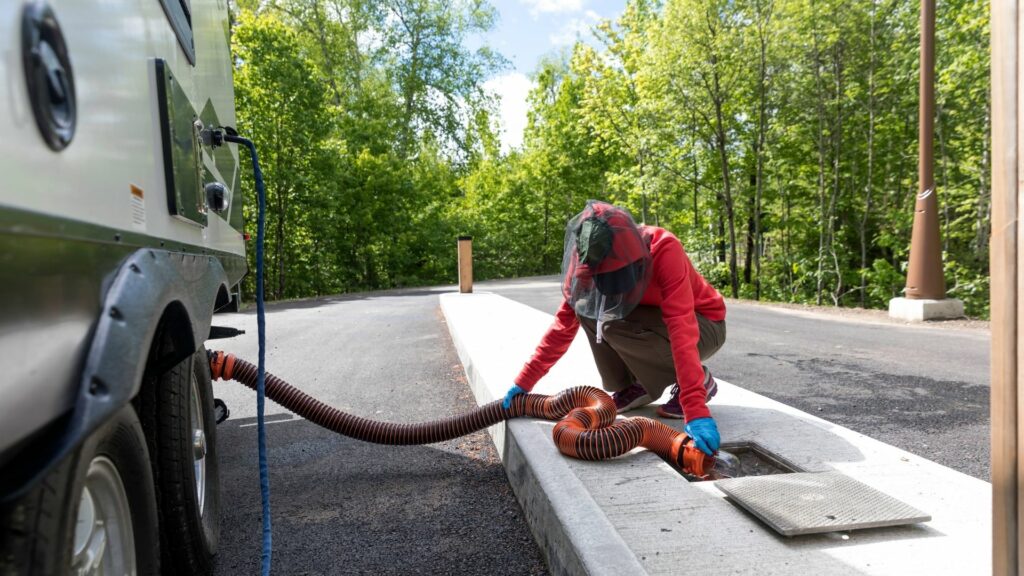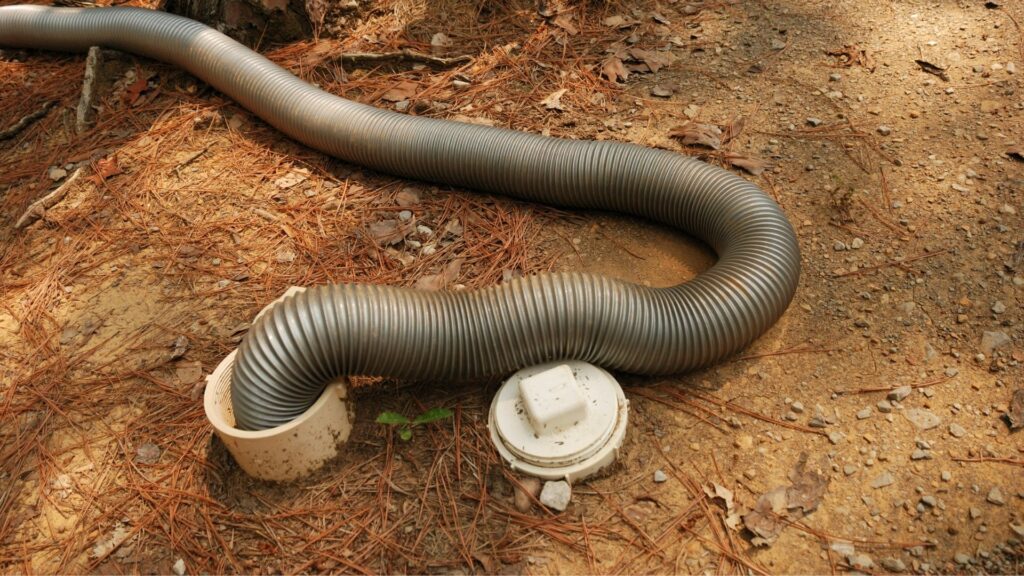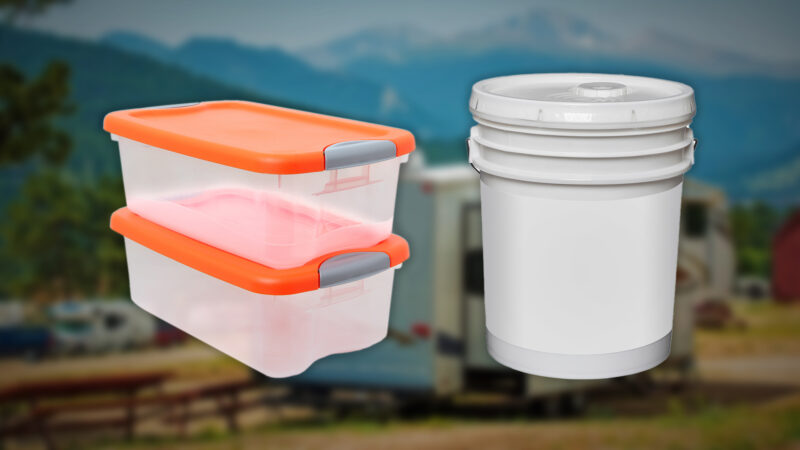Table of Contents Show
Emptying gray and black holding tanks is a necessary task when RVing. But it doesn’t have to be a dirty job. Keeping the process clean and safe starts with sanitary RV sewer hose storage.
In this article, we share 10 sanitary ways to store your hoses. So put your gloves on, and let’s take a look.
How Do I Store My RV Hose?
If you hang out with RVers long enough, the topic often turns to the nasty black tank and sewer hoses. Flopping them loosely into one of your storage bays is not a solution and can be dangerous to your health and the RV. When using this method, bodily fluids can get on other things in the storage bay, or water can leak from the hose on your RV and potentially cause rust or mold. There are much better solutions.
We recommend containing your RV sewer hoses as much as possible. Storing them in sealed bins is often the most convenient option. Or, if you have a hollow rear bumper on your RV, this is a great place to store a sewer hose since it also creates some natural ventilation for the inevitable odors. Keep reading to take a deeper dive into 10 RV sewer hose storage solutions.

How Many Hoses Do You Need for an RV?
The number of sewer hoses you need for an RV can vary depending on where you’re dumping your tanks. If you’ll only be dumping your tanks at a dump station, one five- to 10-ft sewer hose is adequate. But if you plan to stay at campgrounds with sewer hookups at the campsite, there may be times when one hose isn’t long enough to get to the sewer. So you may need to connect two or three hoses to reach from your RV to the sewer in the ground.
We recommend starting with one 10-ft sewer hose and an elbow connector if you have one access point for your gray and black holding tanks. If they’re separate, you’ll need two hoses from the beginning. You can purchase a Y connector to run both hoses together at the campsites’ sewer hole.
Pro Tip: These 20 sewer accessories will help you avoid nasty accidents and bad smells.

10 Sanitary Methods of RV Sewer Hose Storage
It’s a messy job, but someone has to do it. If you plan to use your RV’s toilet and sinks, you’ll have to empty the holding tanks. Keeping this task as sanitary as possible is crucial. We’ve identified 10 RV sewer hose storage methods that will make the job more tolerable.
1. Plastic Storage Bins That Seal Tightly
- MADE IN USA: Quality you can trust! Our storage bins are proudly crafted in the USA using high-quality, durable...
- WEATHERPRO GASKET SEAL: These bins feature top-notch seals in the lid that create a vacuum-like environment to lock out...
Store your RV sewer hoses in plastic storage bins that seal tightly. This will keep the odor and any water or mess inside the hoses. Get a container that will fit inside one of the outdoor storage bays of your RV. Clear bins are also helpful so that you can see what’s inside, especially if you access the hoses infrequently.
2. Magnetic Bumper Caps
- High-strength Neodymium magnets keep the bumper cap in place.Fit Type: Universal Fit
- Features small holes for airflow and doubles as an insect screen
An RV’s hollowed-out rear bumper is one of the easiest RV sewer hose storage locations. Not all RVs have this type of bumper, but it’s the perfect place to store a hose when they do. It will typically only fit one hose.
RV bumpers often come with caps on them, but we recommend switching them out for magnetic caps so they don’t fall off when going down the road. These caps also allow for ventilation to reduce odors in between uses.
3. DIY PVC Pipe That Gets Stored in an RV Storage Bay
You can make your own RV sewer hose storage to resemble a hollow bumper. Get a PVC pipe that fits into your RV’s storage bay, or cut down the tube to fit. You can then store a sewer hose inside the pipe and put caps on either end. This will ensure your storage bay stays clean, and you’ll be able to access your sewer hose when you need it quickly.
Some people will go one step further and permanently attach the PVC pipe to the wall of the storage bay. With this system, you’ll only have to take the cap off and pull the sewer hose out every time you need to use it.
4. Five-Gallon Bucket With a Lid
A five-gallon bucket with a sealed lid is one of the cheapest options for a sanitary RV sewer hose storage solution. You can purchase a bucket from any hardware store. Ensure that it comes with a lid that seals tightly to keep the bucket from releasing odors or spillage. Store the bucket in an outdoor storage bay for easy access, or put it in the bed of your truck or vehicle’s trunk.
5. A Holder Made of a Fence Post
Like the DIY PVC pipe storage solution, you can do the same with a vinyl fence post. You can store the post in your storage bay, attach it below your RV, or attach it where a rear bumper would typically be. Fence posts are typically available up to eight ft long. You can cut it down to the size you need. And we recommend using the magnetic bumper caps we mentioned above to seal each end of the fence post once the sewer hose is inside.
6. Bumper Mounted Storage Box
Storage boxes mounted on RV bumpers are an ever-popular and convenient option for gear. You can also use this method to store RV sewer hoses. This is the perfect option to keep them out of the storage bays and secure in a box. And best of all, accessing the sewer hoses once you’re at a campsite or dump station is very easy.
7. Extendable Waste Hose Carrier
- This sewage hose carrier is expandable and telescoping, available in multiple lengths (33"-60", 43"-80", 53"-100") and...
- Accepting 3" drain hoses, it accepts the common "Rhino Flex" 15-foot sewage hose with all fittings.
RecPro has developed an extendable waste hose carrier that can convert from 43” to 80” long. It’s heavy-duty polymer plastic with secure caps that lock in place. You can store the sewer hose carrier in a storage bay or secure it under your RV. This option is perfect for someone who prefers not to waste time on the DIY PVC pipe sewer hose holder.
8. Under Chassis Storage Unit
- OPTIMAL SPACE- Underchassis storage bins help you free up space in your RV and tow vehicle
- EASY ACCESS - Designed with a spring-loaded latch system that slides the bin in and out with ease
Lippert’s Under Chassis Storage Unit frees up space in your storage bays by providing storage bins that attach under the RV’s chassis. It bolts onto the RV’s frame. The bins can store gear and accessories like sewer hoses. The unit has a spring-loaded latch system that slides the bin in and out for easy access to your hoses.
9. Waterproof RV Hose Bag
- RV HOSE ORGANIZER FOR YOUR RV LIFE - Any RVer will know how difficult it is to keep all your gear and accessories...
- WATERPROOF LINER & BREATHABLE MESH - When putting your hoses away for storage, you’ll notice that there is always...
One of the more recent RV sewer hose storage solutions is a waterproof hose bag. The bag is sectioned off to fit an electrical cord, freshwater hose, and sewer hose. It can fit up to 100 ft of hoses and cords. The interior liner is fully waterproof to prevent moldy build-up. It also has a drawstring tie and grab handle. This is a good option for infrequent camping trips.
10. Garbage Bag
When in desperate need of an RV sewer hose storage solution, you can always turn to a garbage bag. While this is a temporary solution, it can get the job done in a pinch. Just remember to throw the garbage bag away after your camping trip!
Pro Tip: Here are some additional hose storage ideas to make sure your sewer hoses and fresh water hoses are kept separate.
How Do I Clean My RV Black Water Hose?
It’s important to clean your RV black water hose after use. Keeping it clean prevents the build-up of bacteria and grime. A simple way to clean the hose is with a yard water hose. You will also find water hoses at most RV dump stations. In addition, some RVs have a black water tank flush allowing you to flush out the tank with fresh water, which rinses through your sewer hose.
Whenever you’re emptying your black water holding tank, do so before emptying your gray tank. Having the gray water run through the sewer hose after the black tank helps clean out the hose. Also, the gray tank should only have water and soap in it. So even though it’s not clean per se, it still can get rid of some of the muck from the black tank.
Is Sanitary RV Sewer Hose Storage Worth It?
Sanitary RV sewer hose storage is a must. Keeping potential bacteria away from your camping gear will keep you healthy on your trip. At the same time, keeping water from the hose from spilling in your storage bay or on equipment is also essential.
Which of these storage solutions will work best for your RV setup? If you come up with another creative solution, drop us a line in the comments below.
Last update on 2025-01-18 / Affiliate links / Images from Amazon Product Advertising API












Having visited most of the listed sites, suggest adding the Golden Spike NM as a location rich in historical significance.